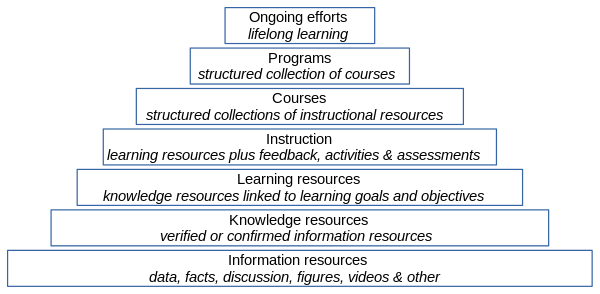Learning resource
Introduction
A learning resource is an artifact that contributes to a learning process. Some authors restrict its meaning to content, others include tools and environments. We suggest making a distinction between resources and tools as in learning design methods, although boundaries overlap. E.g. a wiki is both a resource that contains contents and a tool allowing learners and teachers to write. An other example of non-standard learning resources are student productions that can be just outputs to be evaluated or objects that can be reused in a learning activity or even become resources for other learners.
Spector et al. hierarchy of learning resources
Huang et al. define a hierarchy of learning materials and the learning resource corresponds to one specific element, i.e. materials linked to a learning goal. “Information that has been determined to be reliable and accurate can be considered knowledge and a candidate for inclusion among learning resources. When that knowledge is linked to a learning goal or objective, it can be considered a learning resource. When activities, feedback, and assessment are included with a learning resource, it becomes an instructional object or resource.” (Huang, Spector and Yang, 2019) [1]
The following figure capture the complexity of various types of materials in terms of a hierarchy that begins with information resources at the base of a pyramid and ends with "lifelong learning". Learning resources in the narrow sense are located in the middle.

See also:
Bibliography
- ↑ Huang R., Spector J.M., Yang J. (2019) Introduction to Educational Technology. In: Educational Technology. Lecture Notes in Educational Technology. Springer, Singapore